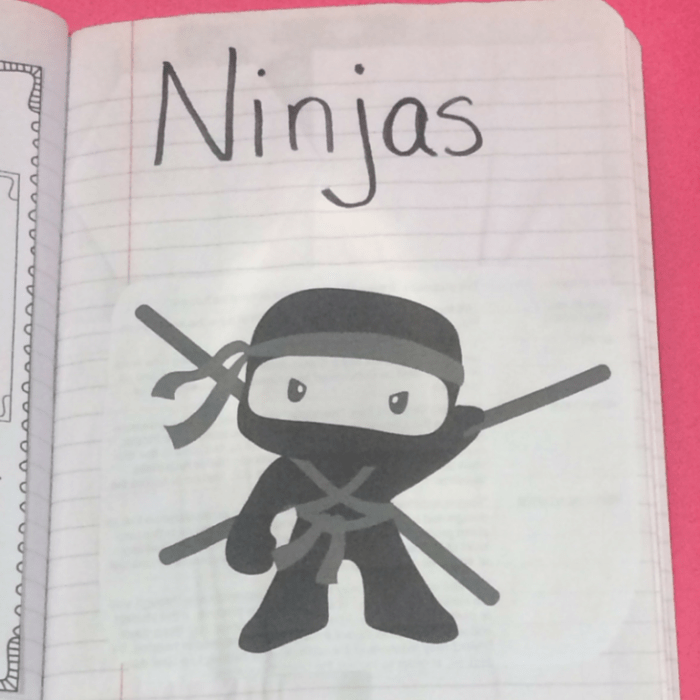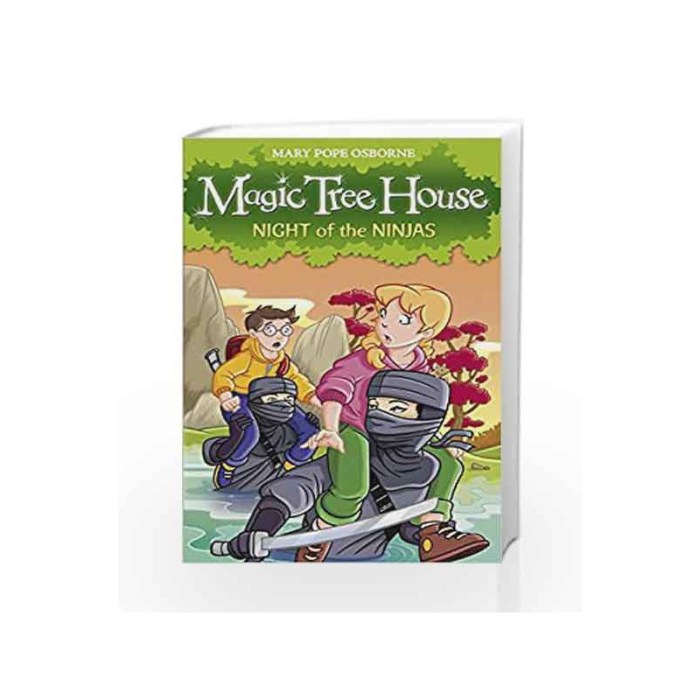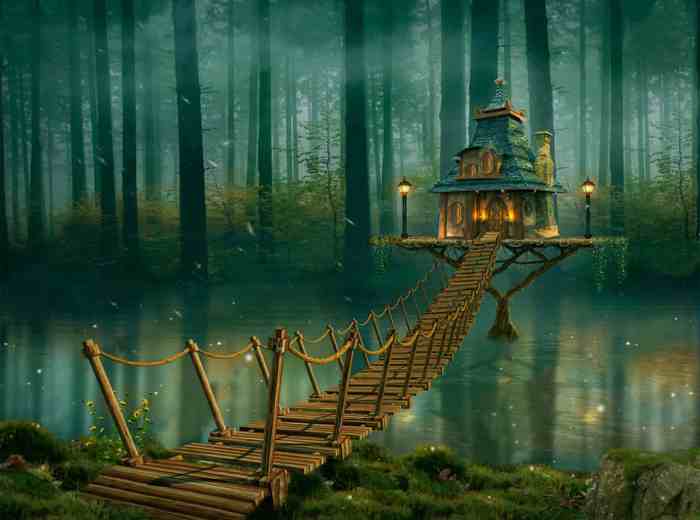Magic tree house night of the ninjas – In “Magic Tree House: Night of the Ninjas,” Mary Pope Osborne weaves a captivating tale that transports young readers into a thrilling historical adventure. Join Jack and Annie as they embark on a time-bending journey to feudal Japan, where they encounter skilled ninjas and uncover secrets of a bygone era.
Through its vivid descriptions, engaging characters, and exploration of cultural diversity, “Magic Tree House: Night of the Ninjas” offers an immersive and educational experience that will captivate young minds.
Story Overview
Magic Tree House: Night of the Ninjasis the eighth book in the popular children’s book series by Mary Pope Osborne. It follows the adventures of Jack and Annie, two siblings who discover a magical tree house that can transport them to different times and places.
In this installment, Jack and Annie are transported to feudal Japan, where they witness the training of a group of young ninjas. The children become entangled in a conflict between the ninjas and a rival clan, and they must use their wits and courage to escape.
Setting
The story takes place in feudal Japan, during the Edo period. The setting is vividly described, with details of the landscape, architecture, and customs of the time.
Characters
- Jack: A curious and adventurous boy who is always eager to explore new places.
- Annie: Jack’s younger sister, who is more cautious than her brother but just as determined.
- Tomo: A young ninja who becomes Jack and Annie’s friend and guide.
- Lord Akimoto: The leader of the ninja clan that Jack and Annie meet.
- The Shadow Clan: A rival ninja clan that is trying to destroy Lord Akimoto’s clan.
Conflicts
- The conflict between the ninjas and the Shadow Clan: This conflict is the main driving force of the story, and Jack and Annie must find a way to resolve it.
- The conflict between Jack and Annie’s desire to explore and their need to stay safe: Jack and Annie are eager to explore feudal Japan, but they also know that they must be careful not to get into trouble.
- The conflict between Jack and Annie’s different personalities: Jack is more impulsive than Annie, and this sometimes leads to disagreements between them.
Time Travel and Historical Context
Night of the Ninjas, the fifth book in the Magic Tree Houseseries, transports siblings Jack and Annie to feudal Japan. The story revolves around the children’s encounter with ninjas, a secretive group of warriors known for their stealth and combat skills.
The time period depicted in the book is the 16th century, a turbulent era in Japanese history marked by political upheaval and civil wars. The country was divided into warring clans, each vying for power and control.
Historical Background
The ninjas were a specialized group of warriors who emerged during this period. They were often hired by feudal lords to carry out covert missions, such as espionage, sabotage, and assassination. Ninjas were trained in a variety of martial arts, including swordsmanship, archery, and hand-to-hand combat.
They were also known for their use of stealth and disguise. They would often wear black clothing to blend into the night and used a variety of tools and weapons to aid them in their missions.
The portrayal of ninjas in Night of the Ninjasis generally accurate and consistent with historical accounts. The book provides a glimpse into the world of these enigmatic warriors and the role they played in Japanese history.
Character Development

Jack and Annie, the protagonists of “Night of the Ninjas,” undergo significant character development throughout the story. They face challenges, learn valuable lessons, and strengthen their bond as siblings.
Growth and Maturity
Jack and Annie’s adventure in feudal Japan forces them to confront their fears and grow as individuals. Jack initially struggles with his impulsiveness but learns to control his emotions and make thoughtful decisions. Annie, on the other hand, overcomes her initial shyness and becomes more assertive in the face of danger.
Challenges and Resilience
The children encounter numerous challenges during their mission, including navigating unfamiliar terrain, facing hostile ninjas, and adjusting to a different culture. Despite the difficulties, they remain resilient and determined to complete their task. Their ability to overcome obstacles and adapt to new situations demonstrates their strength of character.
Sibling Relationship, Magic tree house night of the ninjas
The adventure strengthens the bond between Jack and Annie. They learn to rely on each other for support and guidance. Jack’s protectiveness towards Annie highlights his love for his sister, while Annie’s loyalty to Jack demonstrates her unwavering trust in him.
Themes and Symbolism
Night of the Ninjasexplores several important themes through the use of symbols and motifs.
Courage
The story highlights the importance of courage in the face of danger and uncertainty. Jack and Annie must overcome their fears to rescue their friends and return home. The ninjas represent the challenges and obstacles they must face, but Jack and Annie’s determination and bravery ultimately triumph.
Friendship
Jack and Annie’s friendship is a central theme in the story. They rely on each other for support and encouragement, and their bond helps them overcome the challenges they face. The tree house itself is a symbol of their friendship and the adventures they share.
Cultural Diversity
The story introduces Jack and Annie to a different culture and way of life. They learn about Japanese history and traditions, and they encounter people who are different from them. This exposure to cultural diversity helps them to grow and develop as individuals.
Literary Devices and Techniques
Mary Pope Osborne skillfully employs literary devices to enhance the story’s impact, captivating young readers with foreshadowing, suspense, and vivid imagery.
Foreshadowing
Osborne subtly plants clues throughout the narrative, hinting at future events without explicitly revealing them. For instance, the tree house’s unusual glow and the eerie sounds emanating from it foreshadow the impending ninja encounter.
Suspense
The author builds tension by delaying the resolution of conflicts and creating a sense of anticipation. The children’s initial discovery of the ninja’s presence and their subsequent pursuit of the elusive warriors keep readers on the edge of their seats.
Imagery
Osborne’s vivid descriptions evoke sensory experiences, immersing readers in the story’s setting and atmosphere. She paints a picture of the dense Japanese forest, the stealthy movements of the ninjas, and the vibrant colors of the night sky.
Cultural Connections

The Night of the Ninjas reflects and challenges cultural stereotypes while promoting understanding of Japanese history and customs.
Challenging Stereotypes
The book presents Japanese characters as complex individuals rather than adhering to simplistic stereotypes. The ninjas are not portrayed as inherently evil or mysterious but as skilled and loyal warriors. This challenges the common Western view of ninjas as shadowy and malevolent figures.
Introducing Japanese History and Customs
The story introduces readers to various aspects of Japanese history and culture, including:*
-*Ninja Training
The book depicts the rigorous training and discipline required to become a ninja.
-
-*Japanese Architecture
The ninjas’ hideout in an old temple showcases traditional Japanese architecture and design.
-*Japanese Food
The children encounter Japanese cuisine, such as sushi and mochi, providing a glimpse into Japanese culinary traditions.
By incorporating these cultural elements, the book fosters appreciation for the diversity and richness of Japanese culture.
Illustrations and Visuals
The Night of the Ninjas features a range of illustrations that complement the text and enhance the storytelling experience. Mary Pope Osborne collaborates with Sal Murdocca, an acclaimed illustrator, to create vibrant and detailed artwork that brings the book’s world to life.The
illustrations play a crucial role in establishing the setting and atmosphere of the story. The depiction of the Japanese village, with its traditional houses, lanterns, and cherry blossom trees, immerses the reader in the cultural context of the book. Additionally, the illustrations capture the nighttime atmosphere, with the moon casting long shadows and the stars twinkling in the sky, creating a sense of mystery and adventure.
Visual Elements
Osborne and Murdocca effectively use visual elements to convey information and evoke emotions. For example, the use of close-up shots emphasizes the characters’ facial expressions, allowing readers to understand their thoughts and feelings. The inclusion of panoramic views provides a broader perspective of the surroundings, enhancing the sense of scale and setting.
Moreover, the choice of colors contributes to the overall mood of the story, with warm colors creating a sense of comfort and safety, while cool colors evoke feelings of suspense and danger.
Educational Value

The Magic Tree House: Night of the Ninjas offers a captivating and educational experience for young readers. Through its engaging storyline, the book introduces children to various historical and geographical concepts, fostering their curiosity and inspiring them to explore these subjects further.
History and Geography
- The book transports readers to feudal Japan, immersing them in the historical context of the time period.
- It provides insights into the culture, customs, and daily life of the Japanese people during the feudal era.
- The story also introduces children to geographical concepts, such as the location of Japan, its climate, and the significance of its natural landmarks.
Other Subjects
Beyond history and geography, the book also touches upon other subjects, such as:
- Science:The story includes references to astronomy, as the children navigate their journey using the stars.
- Language Arts:The book encourages vocabulary development through its use of historical terms and Japanese words.
- Problem-Solving:The children encounter challenges throughout their adventure, which require them to think critically and find solutions.
Overall, The Magic Tree House: Night of the Ninjas serves as a valuable educational tool, igniting young readers’ interest in a wide range of subjects and inspiring them to become lifelong learners.
FAQ Explained: Magic Tree House Night Of The Ninjas
What is the main conflict in “Magic Tree House: Night of the Ninjas”?
Jack and Annie must rescue a captured ninja and navigate the dangers of feudal Japan.
How does the story promote cultural understanding?
It introduces readers to Japanese history, customs, and the values of courage and respect.

